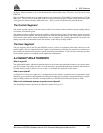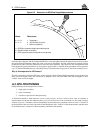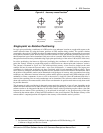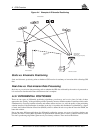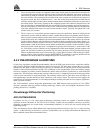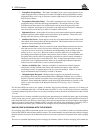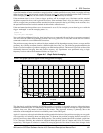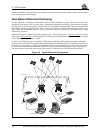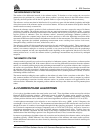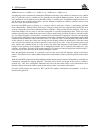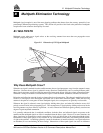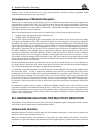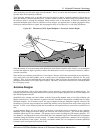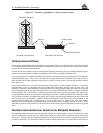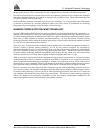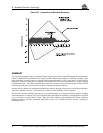
A GPS Overview
MiLLennium GPSCard Software Version 4.50 Command Descriptions Manual Rev 1 71
THE REFERENCE STATION
The nucleus of the differential network is the reference station. To function as a base station, the GPS receiver
antenna must be positioned at a control point whose position is precisely known in the GPS reference frame.
Typically, the fixed position will be that of a geodetic marker or a pre-surveyed point of known accuracy.
The reference receiver must then be initialized to fix its position to agree with the latitude, longitude, and height
of the phase centre of the reference station
GPS receiver antenna. Of course, the antenna offset position from the
marker must be accurately accounted for.
Because the reference station’s position is fixed at a known location, it can now compute the range of its known
position to the satellite. The reference station now has two range measurements with which to work: computed
pseudoranges based on its known position relative to the satellite, and measured pseudoranges which assumes the
receiver position is unknown. Now, the reference station’s measured pseudorange (unknown position) is
differenced against the computed range (based on known position) to derive the differential correction which
represents the difference between known and unknown solutions for the same antenna. This difference between the
two ranges represents the combined pseudorange measurement errors resulting from receiver clock errors,
atmospheric delays, satellite clock error, orbital errors, and
SA.
The reference station will derive pseudorange corrections for each satellite being tracked. These corrections can
now be transmitted over a data link to one or more remote stations. It is important to ensure that the reference
station’s
FIX POSITION setting be as accurate as possible, as any errors here will directly bias the pseudorange
corrections computed, and can cause unpredictable results depending on the application and the size of the base
station position errors. As well, the reference station’s pseudorange measurements may be biased by multipath
reception.
THE REMOTE STATION
A remote station is generally any receiver whose position is of unknown accuracy, but has ties to a reference station
through an established data link. If the remote station is not receiving differential corrections from the reference
station, it is essentially utilizing single point positioning measurements for its position solutions, thus is subject to
the various
GPS system biases. However, when the remote GPS receiver is receiving a pseudorange correction from
the reference station, this correction is algebraically summed against the local receiver’s measured pseudorange,
thus effectively cancelling the effects of orbital and atmospheric errors (assuming baselines < 50 km), as well as
eliminating satellite clock error.
The remote must be tracking the same satellites as the reference in order for the corrections to take effect. Thus,
only common satellites will utilize the differential corrections. When the remote is able to compute its positions
based on pseudorange corrections from the reference station, its position accuracies will approach that of the
reference station. Remember, the computed position solutions are always that of the
GPS receiving antenna phase
centre.
A.4 CARRIER-PHASE ALGORITHMS
Carrier-phase algorithms monitor the actual carrier wave itself. These algorithms are the ones used in real-time
kinematic (RTK) positioning solutions - differential systems in which the remote station, possibly in motion,
requires reference-station observation data in real-time. Compared to pseudorange algorithms, much more
accurate position solutions can be achieved: carrier-based algorithms can achieve accuracies of 1-2 cm (CEP).
A carrier-phase measurement is also referred to as an accumulated delta range (ADR). At the L1 frequency, the
wavelength is 19 cm; at L2, it is 24 cm. The instantaneous distance between a GPS satellite and a receiver can be
thought of in terms of a number of wavelengths through which the signal has propagated. In general, this number
has a fractional component and an integer component (such as 124 567 967.330 cycles), and can be viewed as a
pseudorange measurement (in cycles) with an initially unknown constant integer offset. Tracking loops can
compute the fractional component and the change in the integer component with relative ease; however, the
determination of the initial integer portion is less straight-forward and, in fact, is termed the ambiguity.
In contrast to pseudorange algorithms where only corrections are broadcast by the reference station, carrier-phase
algorithms typically “double difference” the actual observations of the reference and remote station receivers.
Double-differenced observations are those formed by subtracting measurements between identical satellite pairs
on two receivers:



